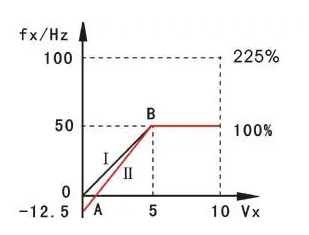Frequency converter bias frequency and frequency gain

Some inverters call the corresponding frequency when the given signal is 0 as the bias frequency, which is represented by fBI. When the given signal X is 0, the output frequency of the inverter is not 0, and the situation of the basic frequency given line is different.
The offset frequency can be expressed directly by the frequency value, or expressed by the percentage of the ratio of the offset frequency to the maximum frequency.
The frequency gain can be seen in the figure. When the given signal is the maximum value Xmax (10V), the percentage of the ratio of the maximum given frequency of the inverter to the actual maximum output frequency is expressed in G%:
G%=×100%
In the formula, G%——frequency gain, %;
fmax——the maximum frequency preset by the inverter, Hz;
fXM——Virtual maximum given frequency, Hz.
Here, when G%<100%, the maximum frequency actually output by the inverter is equal to fXM. When G%>100%, the actual maximum output frequency of the inverter can only be equal to when G%=100%.
In production practice, sometimes the minimum frequency and maximum frequency required by the production machinery are not consistent with the basic frequency given line, so it is necessary to properly adjust the frequency given line to meet the actual production requirements. The so-called adjusting the frequency given line is actually to adjust the starting point and end point of the frequency given line. The offset frequency can be used to adjust the starting point of the frequency reference line, and the frequency gain can be used to adjust the end point of the frequency reference line.





